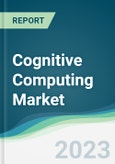The cognitive computing market was valued at US$41.519 billion in 2021 and is projected to expand at a CAGR of 32.14 % over the forecast period to reach US$292.069 billion by 2028.
This research study examines the cognitive computing market based on various segments: technology, end-user, deployment type, industry vertical, and geography. First, a brief overview of the market details key driving factors and challenges. Next, Porter's five forces model analyzes the cognitive computing market comprehensively. This is followed by industry value chain analysis which determines the companies which are part of the different processes and contributing to various sectors.The study also presents in-depth information concerning the development, trends, and industry policies and regulations affecting the cognitive computing market. Moreover, the research study analyzes the overall regulatory framework of the cognitive computing sector, offering stakeholders a better understanding of the key factors influencing the overall market environment.
Cognitive computing market - Forecasts from 2023 to 2028 is a comprehensive and latest report. It provides vital market information to executives and interested stakeholders to enable them to get vital market information. The report also analyzes the competitive landscape and details strategies of key market players and also plots them on our vendor matrix in four quadrants: leader, follower, challenger, and niche.
The scope and coverage of the cognitive computing market report is as below:
- Cognitive computing market data tables and charts
- Market outlook with sections on drivers, restraints, Porter’s and industry value chain analysis
- Market assessment by technology into natural learning processing (NLP), machine learning, automated reasoning, and others (information retrieval).
- Detailed market trends, analysis and graphical representation by end-user into small, medium, and large.
- In-depth analysis of the cognitive computing market by deployment type into cloud based, and on-premise.
- Exhaustive coverage of the industry vertical into healthcare, BFSI, retail, government, military and defense, communication and technology, and others.
- A 360° view of the demand for cognitive computing market solutions/services across different geographies (North America, South America, Europe, Middle East and Africa, and Asia Pacific) with further breakdown for key countries within those regions.
Different segments covered under the cognitive computing market report are as below:
By Technology
- Natural Learning Processing (NLP)
- Machine Learning
- Automated Reasoning
- Others (Information Retrieval)
By End-User
- Small
- Medium
- Large
By Deployment Type
- Cloud Based
- On-Premise
By Industry Vertical
- Healthcare
- BFSI
- Retail
- Government
- Military and Defense
- Communication and Technology
- Others
By Geography
- North America
- United States
- Canada
- Mexico
- South America
- Brazil
- Argentina
- Others
- Europe
- United Kingdom
- Germany
- France
- Spain
- Others
- Middle East and Africa
- Saudi Arabia
- UAE
- Israel
- Others
- Asia Pacific
- Japan
- China
- India
- South Korea
- Indonesia
- Thailand
- Others
Table of Contents
1. INTRODUCTION
2. RESEARCH METHODOLOGY
3. EXECUTIVE SUMMARY
4. MARKET DYNAMICS
5. COGNITIVE COMPUTING MARKET, BY TECHNOLOGY
6. COGNITIVE COMPUTING MARKET, BY END-USER
7. COGNITIVE COMPUTING MARKET, BY DEPLOYMENT TYPE
8. COGNITIVE COMPUTING MARKET, BY INDUSTRY VERTICAL
9. COGNITIVE COMPUTING MARKET, BY GEOGRAPHY
10. COMPETITIVE ENVIRONMENT AND ANALYSIS
11. COMPANY PROFILES
Companies Mentioned
- International Business Machines Corporation (IBM)
- Microsoft
- Nuance Communications
- Hewlett Packard (HP)
- SAS
- SAP
- Oracle Corporation
Methodology

LOADING...
Table Information
| Report Attribute | Details |
|---|---|
| Published | May 2023 |
| Forecast Period | 2021 - 2028 |
| Estimated Market Value ( USD | $ 41.52 billion |
| Forecasted Market Value ( USD | $ 292.07 billion |
| Compound Annual Growth Rate | 32.1% |
| Regions Covered | Global |
| No. of Companies Mentioned | 8 |









